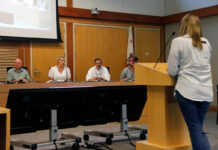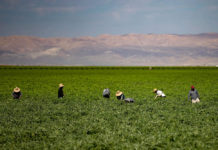When we get thirsty we turn on our taps and voilà, a nice refreshing glass of water appears before us. Having around-the-clock access to safe and reliable drinking water requires huge investments of time and money, but rarely do we consider the source or the value of water.
In Northern California, the Russian River Watershed serves over 600,000 people in Sonoma, Mendocino and Marin Counties. It is also home to approximately 30 species of fish, three of which are listed as threatened or endangered—Chinook salmon, coho salmon and steelhead trout.
The Russian River Watershed is a distinctive, ecologically and economically important hydrologic area of the North Coast. The Russian River, which defines the watershed, originates in Mendocino County, approximately 15 miles north of Ukiah and reaches the Pacific Ocean at Jenner, just 20 miles west of Santa Rosa. Water typically enters the watershed as rain and is either conveyed to streams, rivers, and reservoirs or seeps into the ground to recharge groundwater.
Three reservoirs supply water to the Russian River Watershed: Lake Mendocino on the East Fork of the Russian River, Lake Sonoma on Dry Creek and Lake Pillsbury on the Eel River which flows into Lake Mendocino through PG&E’s Potter Valley Hydroelectric Project. These reservoirs and regional groundwater wells provide water for drinking, fire protection, agriculture, industry, as well as habitat for fish and wildlife.
If you live within the Russian River Watershed, you are most likely connected to a public water system. Water that is supplied by municipalities within the watershed is generally a combination of surface water from the Russian River and local groundwater. Smaller public and private water systems, and rural residential and agricultural water users primarily rely on groundwater wells. The City of Sebastopol, for example, completely relies on groundwater for municipal supply.
To collect water from the Russian River for municipal contractors (including Santa Rosa, Rohnert Park, Cotati, and Windsor), the Sonoma County Water Agency (SCWA) utilizes six collector wells that extend approximately 80 feet below the natural riverbed of the Russian River. As the water is collected, it is naturally filtered through layers of sand, gravel and rock.
Water collected from the Russian River through deep collector wells requires no additional treatment, with the exception of chlorine, which is added for disinfection, and sodium hydroxide, which is added to adjust the pH of the water to reduce corrosion of lead and copper plumbing fixtures.
Groundwater that is pumped by municipal supply wells also typically requires little or no treatment. Potential contaminants, such as metals, petroleum hydrocarbons, bacteria and pesticides are tested for prior to well installation and on a regular basis thereafter. Groundwater treatment usually only includes disinfection and filtration for sediments and other suspended solids.
Water from the Russian River and groundwater wells is supplied to cities and water districts in the region via drinking water distribution systems. Drinking water is required by state law to be tested frequently to ensure that it meets or exceeds drinking water standards at your tap. Local water systems are operated by utility workers, typically municipal employees, who work around the clock to operate and maintain hundreds of miles of pipes. These pipes run underground to homes and businesses within our watershed, providing high-quality and reliable drinking water to our communities every moment of every day.
So the next time you are thirsty, remember that protecting our watershed and investing in our water infrastructure is essential to providing safe, reliable and high-quality water for years to come.
This article was authored by Nicole Dorotinksy and Elise Howard on behalf of the Russian River Watershed Association.







